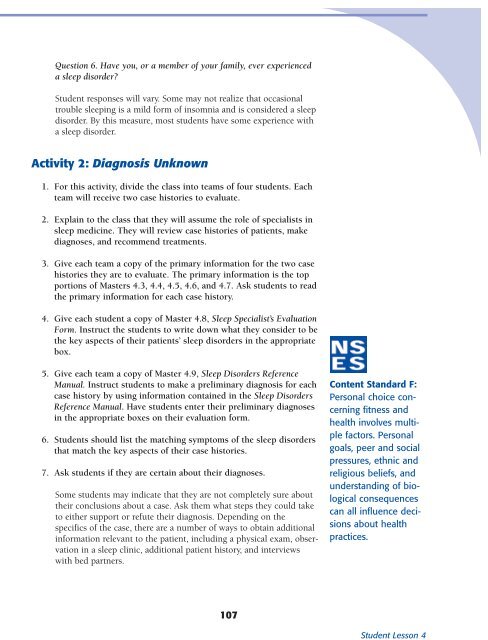Biological - NIH Office of Science Education - National Institutes of ...
Biological - NIH Office of Science Education - National Institutes of ...
Biological - NIH Office of Science Education - National Institutes of ...
Create successful ePaper yourself
Turn your PDF publications into a flip-book with our unique Google optimized e-Paper software.
Question 6. Have you, or a member <strong>of</strong> your family, ever experienced<br />
a sleep disorder?<br />
Student responses will vary. Some may not realize that occasional<br />
trouble sleeping is a mild form <strong>of</strong> insomnia and is considered a sleep<br />
disorder. By this measure, most students have some experience with<br />
a sleep disorder.<br />
Activity 2: Diagnosis Unknown<br />
1. For this activity, divide the class into teams <strong>of</strong> four students. Each<br />
team will receive two case histories to evaluate.<br />
2. Explain to the class that they will assume the role <strong>of</strong> specialists in<br />
sleep medicine. They will review case histories <strong>of</strong> patients, make<br />
diagnoses, and recommend treatments.<br />
3. Give each team a copy <strong>of</strong> the primary information for the two case<br />
histories they are to evaluate. The primary information is the top<br />
portions <strong>of</strong> Masters 4.3, 4.4, 4.5, 4.6, and 4.7. Ask students to read<br />
the primary information for each case history.<br />
4. Give each student a copy <strong>of</strong> Master 4.8, Sleep Specialist’s Evaluation<br />
Form. Instruct the students to write down what they consider to be<br />
the key aspects <strong>of</strong> their patients’ sleep disorders in the appropriate<br />
box.<br />
5. Give each team a copy <strong>of</strong> Master 4.9, Sleep Disorders Reference<br />
Manual. Instruct students to make a preliminary diagnosis for each<br />
case history by using information contained in the Sleep Disorders<br />
Reference Manual. Have students enter their preliminary diagnoses<br />
in the appropriate boxes on their evaluation form.<br />
6. Students should list the matching symptoms <strong>of</strong> the sleep disorders<br />
that match the key aspects <strong>of</strong> their case histories.<br />
7. Ask students if they are certain about their diagnoses.<br />
Some students may indicate that they are not completely sure about<br />
their conclusions about a case. Ask them what steps they could take<br />
to either support or refute their diagnosis. Depending on the<br />
specifics <strong>of</strong> the case, there are a number <strong>of</strong> ways to obtain additional<br />
information relevant to the patient, including a physical exam, observation<br />
in a sleep clinic, additional patient history, and interviews<br />
with bed partners.<br />
Content Standard F:<br />
Personal choice concerning<br />
fitness and<br />
health involves multiple<br />
factors. Personal<br />
goals, peer and social<br />
pressures, ethnic and<br />
religious beliefs, and<br />
understanding <strong>of</strong> biological<br />
consequences<br />
can all influence decisions<br />
about health<br />
practices.<br />
107<br />
Student Lesson 4

















